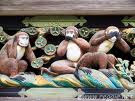monkey teachers . . .
to observe, to listen
to recite haiku
.................................................................................
The "real" Three Wise Monkeys at Nikko
日光の東照宮

|
. The Hill Station of Nagi
那岐山麓山の駅
Here I found these three quite different monkey teachers !
translation by Massa on facebook, March 2011
猿の師は観て聴き話す俳句かな・・・
source : Massa
:::::::::::::::::::::::::::::::::::::::::::::::::::::::::::::::::::::::::::::::::::::::::::::::::::::
The three wise monkeys
(Japanese: 三猿, san'en or sanzaru, or 三匹の猿, sanbiki no saru, literally "three monkeys") are a pictorial maxim. Together they embody the proverbial principle to "see no evil, hear no evil, speak no evil".
The three monkeys are
Mizaru, covering his eyes, who sees no evil;
Kikazaru, covering his ears, who hears no evil; and
Iwazaru, covering his mouth, who speaks no evil. Sometimes there is a fourth monkey depicted with the three others; the last one, Shizaru, symbolizes the principle of "do no evil". He may be shown covering his abdomen or genital area, or crossing his arms.
There are various meanings ascribed to the monkeys and the proverb including associations with being of good mind, speech and action. In the western world the phrase is often used to refer to those who deal with impropriety by looking the other way, refusing to acknowledge it, or feigning ignorance.
Origin
The source that popularized this pictorial maxim is a 17th century carving over a door of the famous Tōshō-gū shrine in Nikkō, Japan. The philosophy, however, probably originally came to Japan with a Tendai-Buddhist legend, from China in the 8th century (Nara Period).
In Chinese, a similar phrase exists in the Analects of Confucius: "Look not at what is contrary to propriety; listen not to what is contrary to propriety; speak not what is contrary to propriety; make no movement which is contrary to propriety" (非禮勿視, 非禮勿聽,非禮勿言, 非禮勿動) It may be that this phrase was shortened and simplified after it was brought into Japan.
Though the teaching had nothing to do with monkeys, the concept of the three monkeys originated from a word play. The saying in Japanese is "mizaru, kikazaru, iwazaru" (見ざる, 聞かざる, 言わざる, or with the suffix in kanji, 見猿, 聞か猿, 言わ猿), literally "don't see, don't hear, don't speak".
Shizaru is likewise written し猿, "don't do".
In Japanese,
zaru, which is an archaic negative verb conjugation, is the same as zaru, the vocalized suffix for saru meaning monkey (it is one reading of 猿, the kanji for monkey). Therefore, it is evident how the monkeys may have originated from what one would see as an amusing play on words.
Three Vajras, a formulation in
Tibetan Buddhism referring to body, speech and mind
Manasa, vacha, karmana, three
Sanskrit words referring to
mind, speech and actions
© More in the WIKIPEDIA !
in Bhutan there are
Ku, Sung and Thuk (thugs in Turrel Wylie)
Ku-Sung-Thuk-Ten
:::::::::::::::::::::::::::::::::::::::::::::::::::::::::::::::::::::::::::::::::::::::::::::::::::::::::::::::::::::::::::
The stone monkeys I found in the temple compound teach quite a different lesson,
or maybe not ?
. Zen and Haiku
. Monkey, a topic for haiku
- Monkey lessons in 2014 -
 source : facebook
source : facebook
:::::::::::::::::::::::::::::::::::::::::::::::::::::::::::::::::::::::::::::::::::::::::::::::::::::::::::::::::::::::::::
 . Doraemon ドラえもん .
. Doraemon ドラえもん .
>
:::::::::::::::::::::::::::::::::::::::::::::::::::::::::::::::::::::::::::::::::::::::::::::::::::::::::::::::::::::::::::
見ざる言わざる聞かざる
 source : www.daruman-honpo.com
source : www.daruman-honpo.com
Daruma and the three monkeys
. Saru 猿 / 申 Monkey Amulets .
:::::::::::::::::::::::::::::::::::::::::::::::::::::::::::::::::::::::::::::::::::::::::::::::::::::
ちりめんの猿狙が三疋梅の花
chirimen no saru ga sanbiki ume no hana
three monkeys
made from chirimen cloth -
plum blossoms
. WKD : Kobayashi Issa 小林一茶 in Edo .

:::::::::::::::::::::::::::::::::::::::::::::::::::::::::::::::::::::::::::::::::::::::::::::::::::::
猿殿の夜寒訪ゆく兎かな
saru dono no yosamu toiyuku usagi kana
stopping in on Mr. Monkey
in the cold of night
a rabbit!
Buson frequently wrote verses anthropomorphizing animals. . . . the speaker describes an encounter between a monkey and a rabbit in fairytale like terms. . . . this kind of humorous and self-deprecating verse is consistent with the aesthetic of fuuga 風雅 (poetic elegance) or fuukyoo 風狂 (poetic madness).
source and more : Cheryl A. Crowley
Enroute to the monkey king
on a cold night,
a visiting rabbit.
Tr. Sawa/ Shiffert
Who goes to visit
Sir Monkey this frozen night -
Only Mr. Hare?
Tr. Nobuyuki Yuasa
The cut marker KANA is at the end of line 3.

兎猿遊戯中巻 - Rabbit and Monkey playing
of the scroll 鳥獣人物戯画 about frolicking animals
- - - - -
mushi no ne ya yami o tachiyuku teoizaru
Chirring of insects--
Cutting through the darkness
Is the cry of a wounded monkey.
Tr. Nelson/Saito
. Yosa Buson 与謝蕪村 in Edo .
:::::::::::::::::::::::::::::::::::::::::::::::::::::::::::::::::::::::::::::::::::::::::::::::::::::
Why is the monkey a symbol of good luck? In Japanese, you can say
ma ga saru 魔が去る, the bad luck is going to leave.
SARU means also monkey, so the monkey might help to make your bad luck go away.
. Monkey Charms, Amulets and Talismans .
:::::::::::::::::::::::::::::::::::::::::::::::::::::::::::::::::::::::::::::::::::::::::::::::::::::

2016 - Year of the Monkey
:::::::::::::::::::::::::::::::::::::::::::::::::::::::::::::::::::::::::::::::::::::::::::::::::::::
. WKD : saru さる - 猿 Monkey, Affe, Affen .
[ . BACK to DARUMA MUSEUM TOP . ]
[ . BACK to WORLDKIGO . TOP . ]
:::::::::::::::::::::::::::::::::::::::::::::::::::::::::::::::::::::::::::::::::::::::::::::::::::::





































